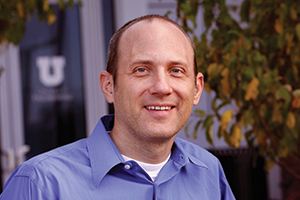
The National Society of Professional Engineers’ publication PE Magazine recently profiled a University of Utah chemical engineering program that allows seniors and freshmen to work together to learn real-world business skills. Below is the story from its January/February edition.
College engineering may not be the work world, but one program is trying to bring it closer. At the University of Utah, a collaboration with seniors and freshmen gives both groups of students valuable professional work experience while taking advantage of the two-way learning that can occur through teaching and mentoring.
In the chemical engineering department, seniors “hire” freshmen to work with them on their capstone projects—developing the seniors’ management skills and improving the freshmen’s understanding of academic and professional pathways.
Associate professor Tony Butterfield explains that many of the graduating seniors would find themselves managing technicians when they entered the workforce, but they hadn’t had experience overseeing a team. In addition, their resumes weren’t grabbing the attention of employers, and Butterfield wanted to provide a way for them to see the hiring process from the other side. Freshmen resumes submitted for his introductory class needed a lot of improvement as well. These factors grew into the idea for the collaboration, which launched in 2013.
Over their first year, freshmen develop their resumes, and toward the end of the spring semester use them to apply for positions on the senior capstone projects they’re most interested in. Seniors then make hiring decisions. The groups, typically three seniors and five freshmen, work together for about three weeks to complete the capstone lab projects.
The reaction from both sets of students has been positive, both anecdotally and on surveys. Seniors have expressed appreciation for the managerial experience, and say they find it helpful to highlight during job interviews.
Freshmen are excited about the opportunity to learn advanced skills from seniors. “They realize they can witness their future — what they’re going to be able to do in a couple of years,” Butterfield says. The freshmen also enjoy informal mentoring as part of the team experience. For example, seniors will tell them the technical electives they got the most out of or describe their experiences with internships. They may even help the freshmen with homework for another class.
In addition, students who identify as underrepresented ethnicities show a “slight but significant” increase in enjoyment of the collaboration over other students, which Butterfield attributes to increasing social connections, including providing valuable access to role models that might not be available among faculty.
Studies show that, overall, improving social connections between students can improve student satisfaction and retention.
The main hurdle Butterfield points to has been logistical issues — particularly, coordinating scheduling. But once he began providing students with information about tools that could help, such as Doodle, that challenge resolved.
Butterfield heads off other potential issues at the start. Seniors get a full day of lectures on teamwork and conflict resolution. They also receive information on cultural sensitivity, since a number of the school’s students come from overseas.
Students who have entered the workforce often praise the way this collabora- tion prepared them. One who returned to campus to recruit employees said this class was the one most like the workplace he experiences every day.
And while Butterfield is a chemical engineering professor, there’s no reason the method couldn’t be applied to other engineering courses with capstone projects. He’s shared information at conferences and in papers, and the idea has been well received.
Time to organize the effort is required at the start, he says, but once the collab- oration is up and running, it continues smoothly with the students and teaching assistants and requires less time from him than a traditional lab class.
The collaboration has won accolades, including contributing toward university awards for Butterfield. In addition, the school’s industrial advisory board has recognized the program for replicating an authentic work environment.
But Butterfield wants to do more. In the spring, he’d like to add an interview component, although he knows it will be logistically challenging, at least at first.
“To me, there’s so much potential in education in senior teams,” he says. “It seems like everybody should be taking advantage of it, because everybody benefits.” Both freshmen and seniors gain important skills, he adds. “It’s a free education, sitting there waiting to be tapped.” — Eva Kaplan-Leiserson, PE Magazine, National Society of Professional Engineers.